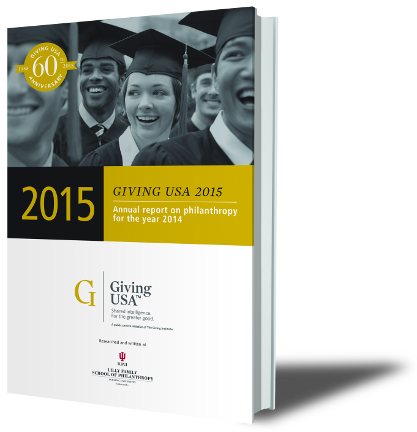 Originally published in the introductory chapters of Giving USA 2015: The Annual Report on Philanthropy for the Year 2014, available now at www.givingusa.org. Expert insights were provided courtesy of Jeffrey Byrne (Jeffrey Byrne + Associates), Keith Curtis (The Curtis Group), Donald Fellows (Marts & Lundy) and David King (Alexander Haas).
Originally published in the introductory chapters of Giving USA 2015: The Annual Report on Philanthropy for the Year 2014, available now at www.givingusa.org. Expert insights were provided courtesy of Jeffrey Byrne (Jeffrey Byrne + Associates), Keith Curtis (The Curtis Group), Donald Fellows (Marts & Lundy) and David King (Alexander Haas).
How to use Giving USA’s intelligence
No matter your role within the nonprofit field—director of development, CEO, board member, or perhaps consultant to charitable organizations—Giving USA 2015 arms you with intelligence to inform and refine your fundraising efforts, educate stakeholders, and benchmark your charity against national trends.
Since all data in the report are historical, how can they tell me where we stand today?
Understanding the history of charitable giving, and comparing it to the history of your own organization, provides valuable insight for how you got to where you are today. That helps you plan for tomorrow.
Straight from the experts
The Giving Institute’s board members represent some of the top minds working in philanthropy today, and several of them contributed advice on how practitioners can dive in and immediately put the content from Giving USA to use:
- Review historical trends in overall giving and giving by nonprofit sector to make informed assumptions about the market for giving on a national level. These data are useful when forecasting for the future and creating models for your campaigns.
- Inform your strategic planning. For example, what educated assumptions about growth in giving over the next few years can you make after reviewing the historical trends?
- Determine where to focus your efforts by understanding trends in giving by the four types of sources—individuals, bequest, foundations, and corporations. Compare the trends against your organization’s historic sources of funding and adjust your outreach as necessary.
- Study trends over time to learn ways donors have earmarked how their gifts can be used. Within the education chapter, for example, research the impact restrictive donations have made on such big-budget items as endowments, facilities, and program support over time.
- Incorporate data and takeaways into your organization’s proposals and communication materials. Transparency with stakeholders is increasingly important.
- Develop more focused and compelling cases for support. Show where your donations are coming from currently, how that matches up with the national picture, and why your budget needs to be adjusted accordingly.
- Dispel myths about fundraising—for example, the misconception that most donations come from corporations and/or foundations.
- Ask yourself what longer-term national trends mean to your organization. For example, the percentage of alumni who donate to their alma mater has been declining for more than two decades. Do you have a plan to address trends like these?
- Educate volunteer leaders about American philanthropy, particularly when it comes to how your organization’s funding patterns and future potential compare to the national picture. Such level-setting will provide them, and other stakeholders assurance that recommendations are based on the best data available and will further understanding about why certain campaign goals have been set.
Take the guesswork out of fundraising
Giving USA will help you unravel economic trends (such as stock market performance, disposable personal income, Gross Domestic Product, and personal consumption) and how they correlate to giving by source—in 2014 and over time. Since these trends are among those closely monitored by people outside the philanthropy sector, being able to discuss them with audiences who consider them important can boost rapport as well as donations.
With three-quarters or more of all charitable donations coming from individuals consistently over the last 60 years, it’s imperative to become familiar with what is happening to personal disposable income. If it’s increasing, you can actively seek new opportunities. If it’s shrinking, you can shift your expectations and use the data to tell your organization’s leaders, volunteers, and donors why.
Once your studies on changes in overall giving are complete, you can apply the same lens to the recipients of those donations: America’s 1 million-plus charitable organizations.
Ask yourself these questions:
- How did my specific subsector perform? They don’t grow or decline at the same rate. For example, if overall giving went up 8 percent, maybe your subsector only saw 3 percent growth. Conversely, maybe your category went up 12 percent.
- Do my organization’s volunteers, leadership, board members, etc., have the same level of understanding about charitable giving? If they don’t, a refresher course (maybe a short presentation) is in order.
- What are the trends behind the raw numbers? Study Giving USA’s data from two different perspectives: Start at 50,000 feet for a holistic view, then dive deep into each sector for context and to understand factors behind increases or decreases.
- Has giving to my subsector been markedly changing since the first Giving USA? If you are in the religion field, for instance, the answer is a definite yes—while the dollars given to religion have grown, the subsector has been losing market share for almost three decades.
- How do these data predict what is going to happen in the future? Much like a stock sales prospectus will tell you that “past results are not an indicator of future performance,” our report can’t tell you exactly what will happen in the future. However, it can help determine some relationships; for example, the close correlation between performance of the S&P 500 and total giving.
Members of The Giving Institute will find additional resources for promoting and sharing Giving USA 2015 within the members only section.